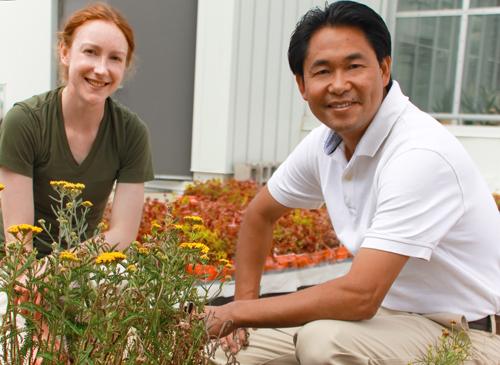Story by Samantha Beattie, a U of G student writer with SPARK (Students Promoting Awareness of Research Knowledge)

Looking out over the rooftops of Berlin, you see an unusually verdant green blended among the black, brown and grey shingles. That’s because “green” roofs – those sporting ornamental and vegetable gardens – have taken hold and proliferated in this vibrant city. Up to 30 per cent of the roofs are green, a trend that’s seen in other great cities such as London, New York City and Tokyo. They’re being adopted as an environmentally friendly innovation that provides storm water management, aesthetics and warmth, all at the same time.
University of Guelph researchers are helping Canadian cities adopt green roofs by making them suitable to a northern climate. Guelph’s green roof research is headed by environmental science professor Youbin Zheng, working with Prof. Mike Dixon. Their goal is to improve existing technology and provide Canadian-adapted technologies to green roof companies.
“What is missing in the Canadian green roof industry is the horticulture knowledge and technology for northern climates that will make our green roofs successful,” says Zheng.
When Toronto passed a by-law in May 2009 requiring that green roofs be built on new developments, the industry boomed. While most green roofs currently sit atop commercial companies, they have the potential to become residential entities as well, cared for by homeowners, says Zheng.
But it won’t come easy. Designing and growing green roofs is a complex process for a host of different reasons. For one, the artificial soil (called “substrate”) must be thin, so it doesn’t exceed the roof’s maximum loading capacity. But at the same time, it must be able to hold water and provide nourishment to the plants.
As well, green roof models from elsewhere must be adapted to unique Canadian conditions. For example, the plants used in Canadian green roofs must be able to withstand the freezing winter climate as well as the hot and dry summer climate.
Zheng and his team are evaluating a variety of plants – from sedum to perennial flower plants and juniper – to find stress-resistant species that can withstand little shelter and more extreme weather conditions than those on the ground. These plants must also be low-maintenance in order to save energy, labour and water and fertilizer costs, as well as to strike a balance between productivity and energy conservation.
Despite the challenges, Zheng wants Guelph to be the go-to place for green roof research for both companies and students. “We want green roof companies and architects to come here, learn from one another and get advice,” says Zheng. “This will also be an opportunity for students to do related research and collaborate across all disciplines.”
Others who are part of the green roof team include lab technician Katie Vinson, graduate student Greg Yuristy, horticulturalists Mary Jane Clark and Linping Wang, plant pathologist Lynn Tian, undergraduate students Siobhan Dunets and Thannushan Nimalendra.
This project receives funding from the Ontario Ministry of Agriculture, Food and Rural Affairs, Carrot Common, Live Roof®Ontario, Sedum Master, Landscape Ontario and Flowers Canada.